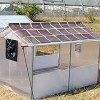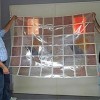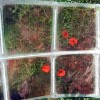
PEROVSKITE SOLAR CELLS AT CHOSE: A NEW PHOTOVOLTAIC TECHNOLOGY

We fabricated perovskite based solar cells using CH3NH3PbI3-xClx with different hole transporting materials such as Spiro-OMeTAD and P3HT. By tuning the energy level of P3HT and optimizing the device’s fabrication, we reached 9.3% of power conversion efficiency showing that P3HT can be a suitable low cost hole transport material for efficient perovskite based solar cells.
[ Di Giacomo et al, J. Power Sources 251, 152 (2014)]
THE PHOTOVOLTAIC GREENHOUSE
We have demonstrated the feasibility of the fabrication of a photovoltaic greenhouse roof by using techniques based on solution processing (spray coating and screen printing). The panel ensures the suitable transmittance for plants and is composed of modules connected in series and parallel.
The work was funded by ECOFLECS Project (partners: Aero Sekur SpA, Uni Roma Tor Vergata, UniTuscia, CNR-IBAF).
A COATING FOR ALL
 Fully sprayed polymer solar cell modules open the way to bring Photovoltaics nominally everywhere, thanks to spray coating conformability to virtually any kind of substrate.
If we also add semitransparency, then the range of possible applications gets even broader, from Building-Integrated Photovoltaics to automotive or consumer electronics.
Fully sprayed polymer solar cell modules open the way to bring Photovoltaics nominally everywhere, thanks to spray coating conformability to virtually any kind of substrate.
If we also add semitransparency, then the range of possible applications gets even broader, from Building-Integrated Photovoltaics to automotive or consumer electronics.
We have set up an automated spray process, completely performed in air, for the fabrication of the first fully spray-coated modules on glass substrates. We have obtained conversion efficiency close to 1% and now the transfer on plastic substrate is in progress, together with the improvement of the efficiency on large area.
Full story available on Energy Technology, in press paper.
Supporting Information: Full Spray and flexible PSC Modules on Action!
SOLID STATE DYE SOLAR CELL MODULES

We fabricated the first solid state dye solar cell (SDSC) module using poly(3-hexilthiophene) (P3HT) as Hole Transport Material for the dye regeneration process. Integrated interconnections were obtained following the "Monolithic" architecture for series connections. The fabricated SDSC module has a conversion efficiency of 2.0% on active area. These results represent a promising starting point for an effective up-scaling of SDSC devices.
Read full article on
Journal of Power Sources Volume 246, 15 January 2014, Pages 361–364.







